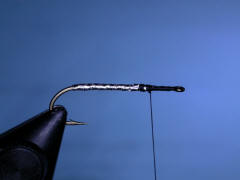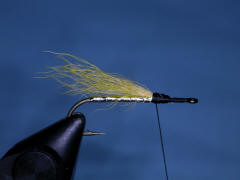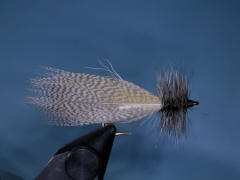|
Fly of
the Month
Bob Ireton brings together his
experience in fly fishing, aquatic entomology, and knowledge of fly
tying techniques and materials, to design and tie durable and
effective flies.
|

|

Volume 6, Issue 7
JULY 2005

HORNBERG
Fly, Text, and Photography by Bob Ireton
The Hornberg is an older pattern, like the Mallard
Minnow. In fact, these two flies resemble one another, except the
Hornberg is a longer fly, and has a rather full hackled collar between
the mallard flank feathers and the hook eye. This is one of those
patterns, like the Muddler Minnow, that can be fished wet or dry. When
treated with dry fly dressing and fished dry, the tented wing of mallard
makes it resemble any of the many caddis flies, especially the large
Salmon fly. Without dressing and fished wet, it can imitate any of a
number of the baitfish, and could be classified as a streamer.
MATERIALS
Hook Daiichi 1750, Mustad 9674, Orvis
0167, TMC 9395, or equivalent.
Size 6-12.
Thread Black 6/0.
Body Flat silver tinsel.
Wing Dyed yellow calf tail hair flanked by two mallard flank
feathers.
Hackle Brown and Grizzly, tied as dry fly hackle.
TYING STEPS - click on
pictures for larger view
|
1 For this fly, I am using a Daiichi 1750
hook, in a size 10. This hook has a micro barb, so I leave it as is.
You may mash down the barb if you are so inclined. Place the hook
properly in the vice, and attach the thread behind the hook eye. Lay on
a base rearward, stopping above the barb. Tie a half hitch. Now, using
well-spaced wraps, bring the thread forward, stopping 1/3 shank length
behind the hook eye. |
 |
|
2 Tie in a piece of the flat silver
tinsel. Tie a half hitch. |
 |
|
3 Palmer the tinsel rearward. When you
reach the end of the thread base, reverse direction, and palmer forward,
forming a nice body. Stop where you started, and tie off the tinsel.
Snip off the excess tinsel, and tie a half hitch. |
 |
|
4 Snip a small bunch of the hair from a
calf tail, and tie it in on top of the hook where you tied in the
tinsel. The length of the wing should be approximately the length of the
hook shank. Of course, as you tie it in 1/3 shank length behind the eye,
the wing will extend this much behind the end of the shank. Snip off the
excess hair, and finish tying in. Tie a half hitch. |
 |
|
5 Pick two mallard flank feathers of equal
size for the feather wings. Dip them in some water to make them moist.
Dont put them in your mouth to do this. Who knows where those feathers
have been! One at a time, stroke the feathers from stem to tip. This
will make the feather much easier to work with. Tie them in on either
side of the hook at the same location as the other materials. Cut off
any excess feather shaft, and finish tying in. Tie a half hitch. |
 |
|
6 Select a brown and a grizzly dry fly hackle of the proper
size, and tie them in adjacent to the mallard feathers so they will
palmer with the shiny side facing forward. Tie a half hitch. |
 |
|
7 Palmer the hackle forward, one feather at a time, and tie off
behind the hook eye. Snip off any excess hackle. Form a head, and tie a
couple of half hitches, then a whip finish. Cut off the working thread,
and apply head cement to the head. |
 |
© 2005 Robert R. Ireton, II
www.buckeyeflyfishers.com
Site designed and maintained by
Panfalone@fuse.net
|







